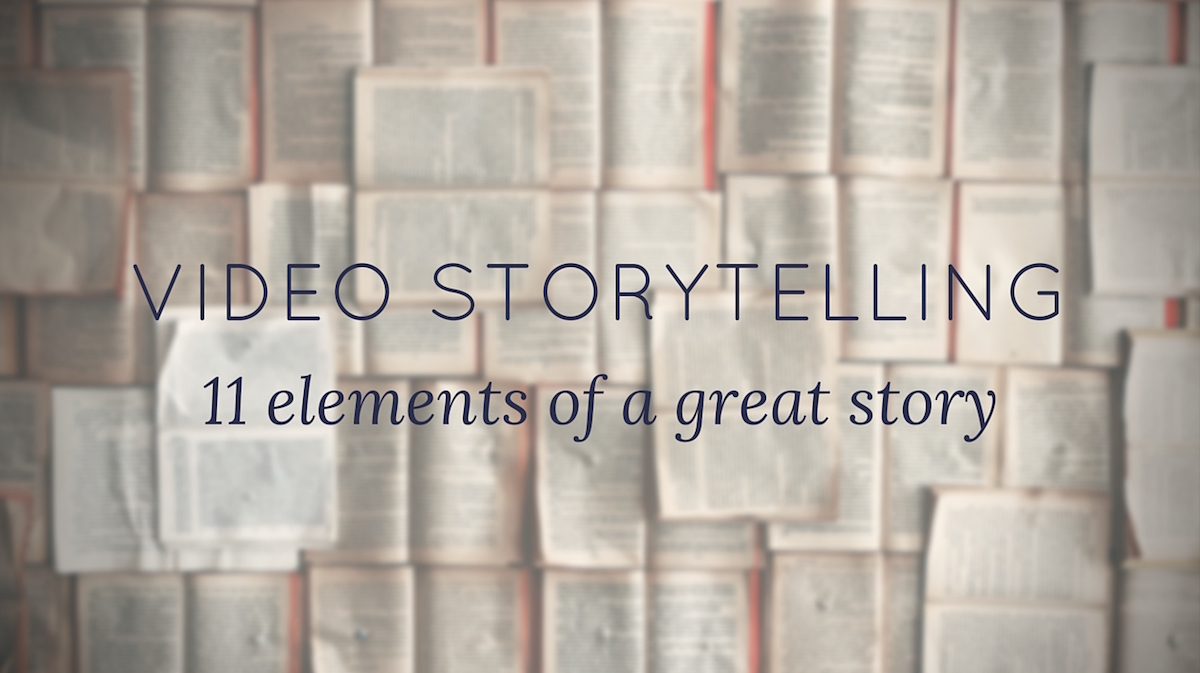Why do we find stories so engaging? Why do tall tales stand clear and vibrant in our memories when facts and figures have long since faded?
Maybe it’s because stories have been the backbone of humanity from day one.
Our ancestors told stories — long before written word — to communicate and pass on knowledge. Committing these stories to memory, each generation then told them to the next. In this way, storytelling acted as an instrument for survival.
Regardless of why we are so enthralled by stories, the fascination we have with them creates an opportunity for you. Marketers have been talking about this opportunity for a few years.
Yep, today we’re going to dive into the art of storytelling — but through the lens of video.

Video can be a compelling medium for storytelling because you’re able to show rather than tell. And with new, amazing technology like 360 video, showing is arguably easier — and more exciting — than ever.
Whether you’re showcasing an event, launching a product, or simply engaging your social media audience, using story in your marketing videos can help your brand stand out from the noise.
But how do you craft a story? Is there a formula? A concrete set of steps?
In this post, I’m going to answer those questions by sharing the 11 core components — essential ingredients, if you will — you need to tell irresistible stories with video.
Note: In your videos, you don’t necessarily have to present the following elements in this order. In fact, many of them might show up simultaneously.
1. Setting
Your story needs context. You must set the stage before your story can make sense.
The setting typically answers what Journalism calls the five Ws: who, what, where, when, and why.
If you’re making a video about your customer (we’ll address why you want to make the video about your customer — and not yourself — in a moment), the setting should address the following questions:
- Who is the customer?
- What is she doing?
- Where is she doing it?
- When is this taking place?
- Why is this happening?
Grabbing attention is critical for online videos. So when it comes to building a setting, be creative and aim to make viewers curious. In some cases, this may mean starting your story in the middle of the action.
2. Protagonist
Frodo Baggins. Luke Skywalker. Harry Potter. Behind every great story is a great hero, otherwise known as the protagonist.
The protagonist is the focal point of a story. It’s also what most businesses get wrong in their marketing.
When we make something that people fork out cash for, it’s easy to think our marketing should be about that product, right? But the reality is consumers — just like you and me — think mostly about themselves.
If you shine the spotlight on your company, viewers will quickly grow bored.
So in your stories, make sure your customer is the protagonist. You can and should feature your brand, too, but only as a supporting character. (More on that below.)
Your protagonist must be relatable, someone your audience can identify with and care about. Root for, even.
This means you must actually know and understand your audience, of course, which is something else altogether. But let’s assume you do know who your ideal customer is.
Tell her story.
3. Goal
Kurt Vonnegut once shared a bit of timeless advice about writing a great story: “Every character should want something, even if it is only a glass of water.”
Giving your protagonist a goal is the key to a meaningful story. The whole plot hinges on it. After all, if your main character doesn’t want something — if she’s perfectly content in life — what’s the point?
Boring.
So ask yourself: What is your protagonist’s ultimate goal? What does she seek? What is she working toward?
4. Obstacle
Your hero needs a villain, your protagonist an antagonist. Yin-yang and all that.
This nemesis acts as the obstacle that’s preventing your protagonist from reaching her goal.
In your videos, the obstacle could be the problem your product addresses, whether it’s bad breath, rainy days, or that three o’clock snack craving.
5. Conflict
Ah, here’s the best part — when things get interesting!
Conflict arises when the protagonist encounters the obstacle, when the hero meets the villain.
Translation: Conflict describes the active struggle of the protagonist (your customer) as she reaches for her goal.
This gap between the protagonist and her goal creates what’s called dramatic tension — the feeling of suspense that hooks us. You likely know it by a simpler name: drama.
Take it from famous playwright David Mamet: “The audience will not tune in to watch information. You wouldn’t, I wouldn’t. No one would or will. The audience will only tune in and stay tuned in to watch drama.”
You need only to turn on the television to witness our addiction to drama. The Real Housewives, Keeping Up with the Kardashians, The Bachelor… should I go on?
This genre — reality TV — is dripping with drama. (A bit too much for me personally, but clearly someone enjoys it!)
6. Mentor
Finally — finally — we’re to you.
So now you know your story must have a setting and a protagonist. And you know the protagonist should want something that’s blocked by an obstacle. All of this causes conflict, for which we crave resolution.
But how?
Enter the mentor. This wise sage comes on the scene to help the protagonist get closer to her goal.
Remember when I mentioned that your story needs to be about your customer, not your brand? Here’s part of the reason why: When you make the story about a character your audience identifies with, they begin to see themselves in the story.
Then when you — the mentor — help the protagonist achieve her goal, your potential customers realize that you are integral to their success.
They imagine themselves using your product. They envision what their lives would look like with your handy little widget in it.
Things click into place, and they understand the connection between you (or your product) and a better version of themselves.
So you may not be the star of the show, but there wouldn’t be a show without you, dear mentor.
7. Token
One way the mentor helps the protagonist is by giving her a token. (Not the Chuck E. Cheese’s kind.) In fictional stories, tokens are often gifts with supernatural qualities.
The lightsaber Obi-Wan Kenobi gives Luke in Star Wars is a token, as is the magical Elvish blade Bilbo Baggins offers Frodo in The Lord of the Rings.
The token in your story could be your product or service — a gift that empowers your protagonist so that she may overcome the obstacle and achieve her goal.
In this captivating video from AirBnB, the Berlin apartment acts as the token (offered by AirBnb) that helps Catherine give her father peace.
8. Before State
The time before the mentor helps the protagonist — while she has an unsolved problem — is known as the before state.
For your customers, the before state is life without your product. It’s here that you should really zero in on the pain point that your product addresses.
Make it hurt!
9. After State
Any guesses what this is? Yes, the after state describes the situation after the protagonist reaches her goal. It’s where you should emphasize your product’s benefits.
Together, the before state and after state form what’s called the storytelling arc.
You can spot the arc in most good customer testimonial videos. The typical structure goes something like this:
- A customer describes a problem she was having.
- She talks about using the brand’s product/solution.
- She shares how it’s resulted in her greater happiness.
10. Emotion
Why do we love to hear and tell stories? Because good stories make us feel something.
And the same should be true of your marketing videos.
Evoke emotion. Yes, exacerbate your customer’s pains and stress your product’s benefits. But above all, be human.
In the past few years, Dove has really excelled at influencing audiences with emotional stories. The brand’s expert delivery could tease empathy from a stone. For example:
We suffer with the protagonist in the before state, and then we celebrate with joy and relief in the after state.
Telling emotional stories will not only make your videos more persuasive, but also encourage viewers to share them.
11. Moral
Throughout history, every story has included one last thing: a moral.
What’s the point? What’s the key idea you could share over coffee?
In marketing-speak, this is the call-to-action. It’s the main message you want viewers to take away. Spell it out for them. Tell them what to do next.
So what should your moral be?
The obvious answer is “buy this product.” But I challenge you to think beyond the product and speak to deeper truth. Because going deeper is how you turn customers into brand advocates.
Some brands have done this remarkably well. An example you’ve probably seen is Chipotle’s animated short, The Scarecrow:
The final frame of the video features this line: “Cultivate a Better World.”
How’s that for inspirational?
Go Forth and Share Awesome (Video) Stories
We’re all storytellers. Some of us are naturally better than others, sure. But if you implement these ingredients of a good story, I guarantee you’ll be creating more powerful videos in no time:
- Setting
- Protagonist
- Goal
- Obstacle
- Conflict
- Mentor
- Token
- Before State
- After State
- Emotion
- Moral
Enjoy this post?
Read more about one technique that makes stories even more compelling: Cliffhangers.
A version of this article originally appeared on SproutVideo.com.

